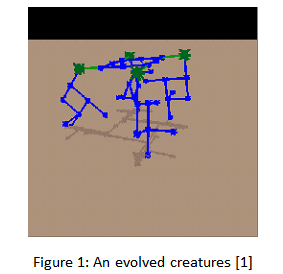Asst. Prof. Dr. Noor D. Al-Shakarchy
Department of Computer Science, Faculty of Computer Science and Information Technology
Artificial life, also known as digital organisms, refers to the simulation of living systems or organisms using computer software and hardware. Digital organisms are computer programs designed to mimic the characteristics and behaviors of living organisms, such as reproduction, mutation, evolution, and adaptation to changing environments. They are virtual creatures that can reproduce, mutate, and evolve in a simulated environment.
Digital organisms are usually implemented as populations of software agents that interact with each other and with their virtual environment as shown in figure 1. They can evolve over time through a process similar to natural selection, where the most successful organisms are more likely to reproduce and pass on their traits to their offspring.

In the context of soft computing, artificial life involves developing computational models of living systems using soft computing techniques. These models can be used to simulate the behavior of living organisms, study the evolution of species, and explore the dynamics of complex ecosystems.
Soft computing techniques are well-suited for modeling and simulating biological systems because they are capable of handling uncertainty, imprecision, and incomplete information. They can also adapt and learn from experience, which is essential for creating intelligent systems that can simulate the behavior of living organisms.
Digital organisms are often used in artificial life research to study the emergence of complex behaviors and to explore the dynamics of evolutionary systems. By creating and studying digital organisms, researchers can gain insights into the fundamental principles of biology and evolution, and develop new algorithms and computational techniques that can be applied to a wide range of scientific and engineering problems. Artificial life has applications in fields such as artificial intelligence, robotics, and evolutionary biology. It can be used to study the behavior of complex systems, simulate the evolution of species over time, and develop algorithms that mimic biological processes.
Artificial life & digital organism characteristics
Artificial life and digital organisms have several key features and characteristics, including:
⦁ Reproduction: Digital organisms have the ability to reproduce themselves through a process of replication.
⦁ Mutation: Like living organisms, digital organisms can undergo random mutations that can lead to changes in their traits and behaviors.
⦁ Evolution: Digital organisms can evolve over time through a process of natural selection, where those organisms with traits that are better suited to their environment are more likely to survive and reproduce.
⦁ Adaptation: Digital organisms can adapt to changes in their environment through the process of evolution, allowing them to better survive and thrive.
⦁ Emergence: Complex behaviors and patterns can emerge from the interactions of many simple digital organisms, without the need for a centralized controller or planner.
⦁ Diversity: Digital organisms can exhibit a wide range of behaviors and traits, including cooperation, competition, and symbiosis, leading to diverse populations.
⦁ Interactivity: Digital organisms can interact with each other and with their environment, allowing them to form complex ecosystems and communities.
Artificial life & digital organism Applications
Artificial life and digital organisms have a wide range of applications across various fields, including:
⦁ Evolutionary biology: Artificial life and digital organisms can be used to simulate and study the processes of evolution and natural selection, providing insights into the behavior and characteristics of real organisms.
⦁ Artificial intelligence and robotics: Digital organisms can be used to develop and test algorithms for artificial intelligence and robotics, as well as to study the behavior of complex systems.
⦁ Computational science: Artificial life and digital organisms can be used to simulate and study complex systems in fields such as physics, chemistry, and materials science.
⦁ Game development: Digital organisms can be used to create more sophisticated and realistic game environments, providing more challenging and dynamic gameplay.
⦁ Education and research: Artificial life and digital organisms can be used as educational tools to teach concepts in biology, computer science, and other fields. They can also be used for scientific research in fields such as ecology and evolutionary biology.
⦁ Bio-inspired design: Artificial life and digital organisms can be used to inspire new designs for engineering, architecture, and other applications based on biological principles.
Overall, artificial life and digital organisms have many potential applications in diverse fields, providing new ways to study and understand complex systems and developing innovative solutions to real-world problems.
Refference
⦁ H. Lipson and J. B. Pollack (2000), “⦁ Automatic design and Manufacture of Robotic ⦁ Lifeforms”, Nature 406, pp. 974-978
Mark Daniel Ward, Virtual Organisms: The Startling World of Artificial Life Hardcover, Thomas Dunne Books, November 14, 2000.
Steven Levy, Artificial Life: A Report from the Frontier Where Computers Meet Biology Paperback, Knopf Doubleday Publishing Group, July 27, 1993.





























































